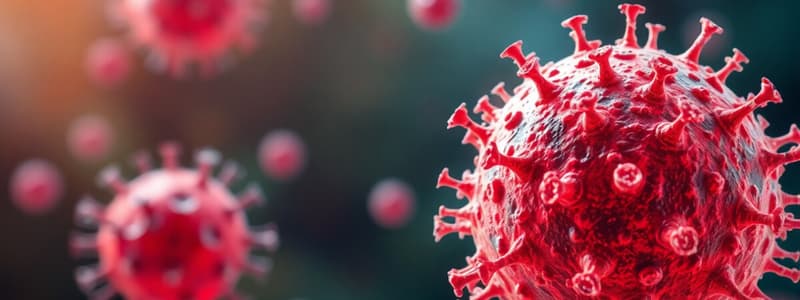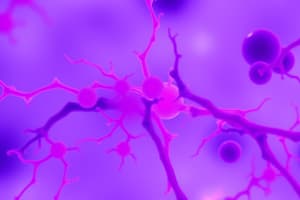Podcast
Questions and Answers
What common environmental toxic agents can cause cell injury?
What common environmental toxic agents can cause cell injury?
- Ethanol, aspartame, and CO2
- Asbestos, insecticides, and social stimulants (correct)
- Sodium, chlorine, and nitrogen
- Ozone, pesticides, and carbon monoxide
Which of the following is NOT a mechanism by which poisons cause cellular damage?
Which of the following is NOT a mechanism by which poisons cause cellular damage?
- Altering membrane permeability
- Disrupting osmotic homeostasis
- Damaging enzymes or cofactors
- Inhibiting cellular respiration (correct)
How can nutritional imbalances result in cell injury?
How can nutritional imbalances result in cell injury?
- Both deficiencies and excesses can cause injury (correct)
- Nutritional imbalances do not affect cell health
- Only deficiencies lead to cell injury
- Excess nutrition is harmless to cells
What kind of injuries can genetic defects trigger?
What kind of injuries can genetic defects trigger?
Which of these is an example of a physical agent that can cause cellular injury?
Which of these is an example of a physical agent that can cause cellular injury?
What type of immune reaction can result in cell injury?
What type of immune reaction can result in cell injury?
Which condition is associated with a nutritional deficiency leading to cell injury?
Which condition is associated with a nutritional deficiency leading to cell injury?
How can therapeutic drugs inadvertently cause cell injury?
How can therapeutic drugs inadvertently cause cell injury?
What is a key factor that leads to cell injury?
What is a key factor that leads to cell injury?
Which type of cell injury is characterized by the cells being unable to recover?
Which type of cell injury is characterized by the cells being unable to recover?
Which of the following causes is primarily associated with a deficiency of oxygen?
Which of the following causes is primarily associated with a deficiency of oxygen?
How can hypoxia be differentiated from ischemia?
How can hypoxia be differentiated from ischemia?
What can an excessive concentration of glucose lead to?
What can an excessive concentration of glucose lead to?
What is one major intrinsic factor that contributes to cellular injury?
What is one major intrinsic factor that contributes to cellular injury?
What is an effect of oxygen at high partial pressures?
What is an effect of oxygen at high partial pressures?
Which of the following best describes the progression of cell injury?
Which of the following best describes the progression of cell injury?
What is a primary structural target for cell damage?
What is a primary structural target for cell damage?
Which condition is the most common cause of cell injury in clinical medicine?
Which condition is the most common cause of cell injury in clinical medicine?
What happens to anaerobic energy generation in ischemic tissues?
What happens to anaerobic energy generation in ischemic tissues?
What are the functional consequences of hypoxia on heart muscle after coronary occlusion?
What are the functional consequences of hypoxia on heart muscle after coronary occlusion?
Which of the following is a characteristic of reversible cell injury?
Which of the following is a characteristic of reversible cell injury?
What accumulates in cells during reversible cell injury due to altered metabolism?
What accumulates in cells during reversible cell injury due to altered metabolism?
What leads to clumped nuclear chromatin in cells experiencing reversible injury?
What leads to clumped nuclear chromatin in cells experiencing reversible injury?
What happens if hypoxia continues in a cell?
What happens if hypoxia continues in a cell?
What initiates the formation of free radicals in the body?
What initiates the formation of free radicals in the body?
Which of the following statements best describes free radicals?
Which of the following statements best describes free radicals?
Which antioxidants are examples of molecules that help remove free radicals?
Which antioxidants are examples of molecules that help remove free radicals?
What effect do free radicals have on DNA?
What effect do free radicals have on DNA?
How can the complement system contribute to inflammation?
How can the complement system contribute to inflammation?
What is a primary consequence of excessive intracellular Ca+2 influx?
What is a primary consequence of excessive intracellular Ca+2 influx?
Which cellular processes are known to generate free radicals?
Which cellular processes are known to generate free radicals?
What process describes the interaction of free radicals with proteins?
What process describes the interaction of free radicals with proteins?
What is one of the key characteristics of reversible cell injury?
What is one of the key characteristics of reversible cell injury?
Which of the following organ characteristics is NOT associated with reversible cell injury?
Which of the following organ characteristics is NOT associated with reversible cell injury?
What occurs if ischemia persists beyond the point of reversible injury?
What occurs if ischemia persists beyond the point of reversible injury?
Which of the following is NOT a mechanism associated with irreversible cellular injury?
Which of the following is NOT a mechanism associated with irreversible cellular injury?
During reperfusion injury, what harmful effect can occur upon restoration of blood flow?
During reperfusion injury, what harmful effect can occur upon restoration of blood flow?
What is the primary consequence of massive calcium influx into the cell?
What is the primary consequence of massive calcium influx into the cell?
Which enzymes are indicators of tissue damage in cardiac muscle?
Which enzymes are indicators of tissue damage in cardiac muscle?
What is a result of disrupted calcium homeostasis in cellular injury?
What is a result of disrupted calcium homeostasis in cellular injury?
Study Notes
Cell Injury Overview
- Cell injury occurs when stresses exceed adaptive capacity or when cells encounter damaging agents or intrinsic defects.
- Injury progresses from a reversible stage to irreversible cell death.
Types of Cell Injury
- Reversible Injury: Damage can be repaired if the harmful stimulus is removed.
- Irreversible Injury: Results in cell death due to extensive damage.
Causes of Cell Injury
- Hypoxia: Oxygen deficiency leading to impaired aerobic respiration; often caused by ischemia, pneumonia, blood loss anemia, or carbon monoxide poisoning.
- Chemical Agents: Can include common substances like glucose and salt; toxic agents alter membrane permeability and enzyme integrity.
- Infectious Agents: From viruses to larger parasites can cause cellular damage.
- Immunological Reactions: Autoimmune responses or allergic reactions may inflict damage to tissues.
- Genetic Defects: Can lead to congenital malformations or metabolic enzyme deficiencies.
- Nutritional Imbalances: Includes deficiencies and excesses, with obesity and specific vitamin deficiencies being notable examples.
- Physical Agents: Trauma, extreme temperatures, radiation, electric shock, and atmospheric pressure changes can cause injury.
- Aging: Leads to diminished cellular functionality and repair capabilities.
Principal Structural Targets for Cell Damage
- Plasma and organellar membranes, DNA, structural and enzymatic proteins, and mitochondria.
Ischemic and Hypoxic Injury
- Ischemia is the most common cause of cell injury as it stops substrate delivery needed for anaerobic metabolism, leading to quicker tissue damage compared to hypoxia.
Pathogenesis of Hypoxic Injury
- Reversible Phase: Includes ATP loss, cell swelling, increased lactic acid, and reduced protein synthesis.
- Irreversible Phase: Marked by calcium accumulation, activation of degradative enzymes, and lethal cell damage.
Reversible Cell Injury Characteristics
- Changes occur early during cell injury, can include organ swelling and fatty changes in metabolically active cells.
Morphological Changes in Reversible Injury
- Gross changes: Increased pallor and turgor, yellowish discoloration from fatty changes, especially in organs like the liver and heart.
- Microscopic changes: Cellular swelling, fatty changes, increased eosinophilia, and surface blebbing.
Irreversible Injury and Necrosis
- Characterized by mitochondrial and lysosomal swelling, membrane damage, enzymatic leakage, and elevated levels of specific proteins in serum indicating tissue necrosis.
Non-Ischemic Cell Injury Pathogenesis
- ATP synthesis reduction, calcium homeostasis loss, disrupted membrane permeability, and oxidative stress during ischemia/reperfusion can exacerbate cellular damage.
Free Radical-Induced Cell Injury
- Free radicals are highly reactive due to unpaired electrons and can cause cell injury through membrane lipid peroxidation, protein damage, and DNA breaks.
- Generated by redox reactions, sensory stimuli, and metabolism; antioxidants and enzymes can mitigate their effects.
Free Radical Removal Mechanisms
- Spontaneous decay, antioxidant vitamins, storage proteins, and specific enzymes such as catalase and superoxide dismutase help neutralize free radicals.
Studying That Suits You
Use AI to generate personalized quizzes and flashcards to suit your learning preferences.
Description
This quiz explores the effects of aging on cellular mechanisms, including the impacts of altered atmospheric pressure and cellular senescence. It covers how these factors contribute to the structural damage of cells, affecting their ability to repair and respond to damage. Test your knowledge on the principle targets for cell damage and the overall implications on organism health.



